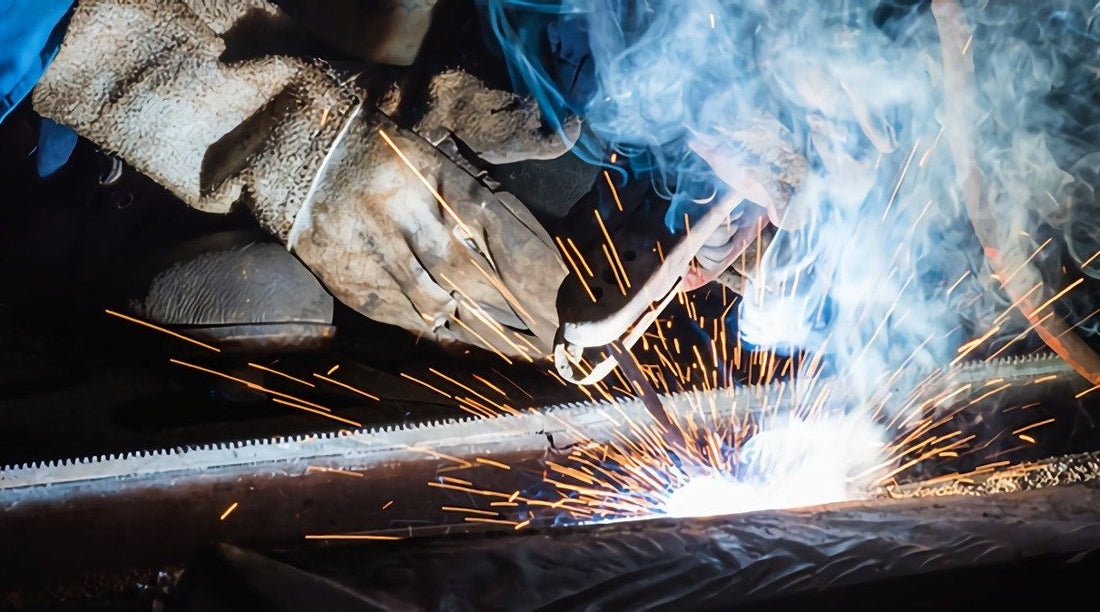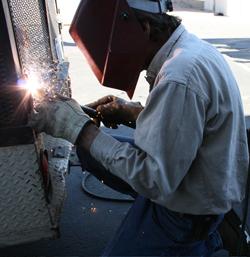Typical Welding Fixing Issues and How to Address Them Successfully
Welding repair work frequently run into an array of problems that can jeopardize the stability of the final item. Common troubles consist of inadequate penetration, porosity, and imbalance, to name a few. Each defect presents unique challenges that call for certain approaches for resolution. Comprehending these concerns is necessary for welders intending to improve their abilities and results. This discussion will certainly discover these usual welding repair work issues and effective approaches to address them.
Insufficient Penetration
Inadequate penetration happens when the weld metal falls short to totally fuse with the base material, leading to weak joints and prospective structural failures. This problem frequently originates from insufficient heat input, wrong electrode angle, or incorrect welding speed. Welders might encounter inadequate penetration as a result of a mistake of the required criteria for a specific product thickness or type. In addition, contamination on the base product's surface can prevent reliable bonding, aggravating the issue. To attend to poor infiltration, welders must assure proper settings on their tools and keep a tidy work surface area. Regular assessment of welds is suggested to identify any kind of shortages early, enabling prompt improvements and the avoidance of endangered structural honesty in welded assemblies.
Porosity
Porosity is an usual issue in welded joints that materializes as tiny gas bubbles trapped within the weld steel. This defect can endanger the integrity of the weld, leading to minimized stamina and potential failing under anxiety. Montana Mobile Welding and Repair Fabrication. Porosity generally emerges from contamination, moisture, or incorrect welding methods, which permit gases to get away right into the liquified weld pool. To address porosity, welders should guarantee appropriate surface prep work, keep a clean workplace, and use appropriate welding parameters. In addition, selecting the best filler material and protecting gas can alleviate gas entrapment. Regular evaluation and testing of welds can aid determine porosity early, ensuring prompt rehabilitative actions are taken, consequently maintaining the high quality and dependability of the welded framework
Imbalance
Misalignment in welding can develop from numerous elements, consisting of incorrect setup and thermal growth. Understanding the origin triggers is crucial for effective resolution. A number of modification strategies are available to realign parts and assure structural honesty.
Root causes of Imbalance
Welding misalignment usually stems from a range of underlying concerns that can endanger structural integrity. One key cause is inappropriate fit-up of components before welding, which can lead to gaps and uneven surface areas. Variants in thermal growth throughout the welding procedure can likewise lead to distortion, especially if the materials being signed up with have various coefficients of expansion. Additionally, poor fixturing and clamping may stop working to hold elements firmly in position, causing movement during welding. Inadequately kept tools, including welding devices and tools, may introduce disparities in the weld bead, further adding to imbalance. Ultimately, operator error, originating from inadequate training or experience, can also play a substantial duty in creating misaligned welds.
Adjustment Strategies Offered
Dealing with imbalance properly requires a combination of rehabilitative techniques customized to the particular problems available. One usual method is making use of components or jigs to hold components in the appropriate setting throughout welding, making certain constant positioning. In addition, pre-heating the materials can help in reducing distortion and improve fit-up. For considerable misalignment, mechanical adjustment techniques, such as using hydraulic jacks or clamps, can be used to remedy the setting before welding. Post-weld warm therapy might likewise be necessary to alleviate tensions brought on by imbalance. Mindful inspection and change during the arrangement stage can avoid misalignment concerns from coming to be considerable issues, promoting a smoother welding process and improving total architectural honesty.
Distortion
Distortion is an usual challenge in welding that can arise from various elements, consisting of uneven heating & cooling. Understanding the root causes of distortion is important for applying effective avoidance techniques. Addressing this concern not only improves structural integrity yet also enhances the general quality of the weld.
Root causes of Distortion
When based on the extreme heat of welding, materials frequently undertake changes that can lead to distortion. This sensation largely arises from thermal development and contraction throughout the welding procedure. As the weld location warms up, the product expands; upon cooling, it contracts, which can create inner tensions. Additionally, irregular heating across a workpiece can intensify these stress and anxieties, leading to warping or bending. The type of material likewise plays a considerable function; steels with varying thermal conductivity and coefficients of development may respond in different ways, leading to uncertain distortions. In addition, poor joint layout and insufficient fixturing can add to imbalance throughout welding, boosting the possibility of distortion. Understanding these causes is crucial for effective welding fixing and avoidance methods.
Prevention Techniques
Reliable prevention techniques for distortion during welding concentrate on managing heat input and making certain correct joint style. Maintaining a constant heat input assists to decrease thermal development and contraction, which can cause distortion. Utilizing strategies such as preheating the work surface can likewise reduce the temperature level slope, promoting uniform home heating. Additionally, picking appropriate joint styles, such as T-joints or lap joints, can improve security and lower stress and anxiety focus. Executing proper fixturing to safeguard the work surfaces in location better aids in keeping positioning during the welding procedure. Staggered welding sequences can distribute warm much more uniformly, avoiding localized distortion. By using these techniques, welders can significantly decrease the chance of distortion and improve the total quality of their welds.
Breaking
Breaking is a common issue encountered in welding fixings, usually arising from numerous elements such as inappropriate air conditioning prices, material choice, or insufficient joint preparation. The event of splits can considerably compromise the stability read more of the weld, bring about possible failures throughout operation. To address this issue, welders need to initially analyze the root triggers, guaranteeing that products work and appropriately chosen for the certain application. Furthermore, managing the cooling rate throughout the welding procedure is important; rapid cooling can induce stress and anxiety and cause splitting. Correct joint style and prep work also contribute to minimizing the danger. Carrying out these strategies can improve weld quality and durability, inevitably decreasing the probability of fracturing in completed weldments.

Incomplete Blend
A significant problem in welding repair work is insufficient blend, which occurs when the weld metal does not sufficiently bond with the base material or previous weld passes browse around this web-site - Montana Mobile Welding and Repair Belgrade Fabrication. This defect can bring about weaknesses in the joint, potentially jeopardizing the honesty of the welded structure. Aspects adding to incomplete fusion include not enough warmth input, incorrect welding method, and contamination of the surfaces being signed up with. To address this problem effectively, welders need to guarantee proper pre-weld cleansing and surface area preparation, along with readjust their welding specifications to achieve appropriate infiltration and combination. Routine evaluation during the welding process can also assist identify incomplete fusion early, enabling prompt restorative procedures to boost the general top quality of the weld
Overheating
While welding repairs can boost structural stability, overheating presents a significant obstacle that can bring about product deterioration. Too much warmth during welding can alter the mechanical homes of metals, causing decreased toughness, raised brittleness, and bending. This phenomenon is particularly essential in high-stress applications where architectural dependability is critical. Recognizing overheating can involve aesthetic assessments for staining or distortion, along with checking temperature throughout the welding process. To alleviate the risks connected with overheating, welders ought to utilize proper strategies, such as managing warmth input, readjusting traveling rate, and utilizing appropriate filler products. Additionally, implementing pre- and post-weld heat treatments can assist bring back product properties and boost the general high quality of the repair, guaranteeing lasting efficiency and safety and security.
Regularly Asked Questions
What Are the Usual Indicators of a Welding Problem?

How Can I Examine My Welds for High quality?
To check welds for quality, one can utilize aesthetic evaluations, ultrasonic testing, and radiographic approaches. Each method guarantees architectural stability, identifies issues, and validates adherence to defined requirements, inevitably boosting the integrity of the bonded joints.
What Safety Safety Measures Should I Take While Welding?
When welding, one should prioritize security by putting on proper personal protective tools, making certain proper ventilation, securing combustible materials away, maintaining a tidy work space, and recognizing environments to stop injuries and accidents.
Can I Fix a Weld Without Redoing the Entire Joint?
Fixing a weld without redesigning the entire joint is possible, relying on the damages (Fabrication). Strategies such as grinding, adding filler product, or utilizing a welding procedure can properly deal with certain imperfections while maintaining the bordering framework
What Equipment Are Crucial for Efficient Welding Fixes?
Essential tools for reliable welding fixings include a welding equipment, cable brush, grinder, safety equipment, clamps, and filler products. Each tool plays an important function in making sure quality and safety during the repair service procedure. Porosity generally discover this arises from contamination, dampness, or incorrect welding methods, which allow gases to leave into the molten weld pool. Badly conserved tools, including welding machines and tools, may introduce inconsistencies in the weld bead, more contributing to imbalance. When subjected to the extreme warm of welding, materials frequently undertake adjustments that can lead to distortion. Breaking is a common concern come across in welding repairs, often resulting from numerous aspects such as improper air conditioning prices, material selection, or inadequate joint prep work. A significant problem in welding repairs is incomplete blend, which occurs when the weld metal does not adequately bond with the base product or previous weld passes.